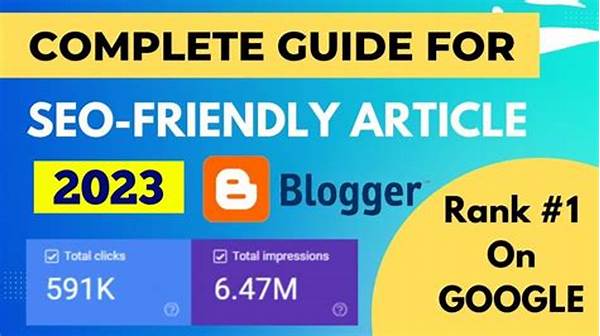Crafting a blog post can often feel like a daunting task, especially when the goal is to make it rank high in search engines. However, by understanding a few key principles, you can create content that is both engaging for your audience and optimized for search engines. This guide will walk you through how to write SEO-friendly blog articles in a way that sounds natural and authentic.
Understanding SEO Basics for Bloggers
Before diving into the realm of SEO, it’s important to appreciate its fundamentals. When considering how to write seo-friendly blog articles, start by keeping your audience in mind. Search engines aim to serve the most relevant content, so understanding what your audience is searching for can help you tailor your content effectively. Research keywords related to your topic, yet aim to integrate them seamlessly into your writing. The goal is to enhance your content’s visibility without compromising its readability or natural flow.
Next, formatting is key. Use headings and subheadings (like H2s) not only to break up the text but also to signal to search engines the important sections of your article. This structural approach not only aids in SEO but also helps readers navigate your content more easily. Remember, the more digestible the content, the more likely readers will engage with it, boosting your post’s performance.
Additionally, it’s essential to maintain a natural tone throughout your writing. When learning how to write seo-friendly blog articles, writers often make the mistake of keyword stuffing, which can lead to awkward sentence structures. Focus on delivering valuable content. Provide answers to potential questions your audience might have. When users find your content helpful, they’re more likely to share it, naturally increasing your reach and ultimately benefiting your SEO efforts.
Practical Steps for Writing SEO-Friendly Content
1. Conduct Keyword Research: Identify relevant keywords to guide how to write seo-friendly blog articles that appeal to your target audience.
2. Use Keywords Naturally: Integrate keywords seamlessly to maintain the flow and coherence of your article.
3. Optimize Titles and Headings: Ensure your titles are engaging and incorporate keywords for better visibility.
4. Enhance Readability: Use short paragraphs and bullet points to make your content easier to digest.
5. Incorporate Internal and External Links: They enhance credibility and provide additional value by directing readers to further information.
Crafting Content with a Natural Tone
Finding the balance between SEO optimization and maintaining a natural tone is crucial when considering how to write seo-friendly blog articles. Readers are more attracted to content that sounds genuine and meets their needs. This means you should write with the intent to educate and engage rather than purely focusing on ranking.
When you prioritize your audience’s experience, you naturally create content that resonates. Aim to communicate complex ideas in a straightforward manner and always write with clarity. Write as if you’re having a conversation with your reader, which naturally enhances engagement and retention. It’s this approachable style that helps to integrate SEO elements without compromising the authenticity of your message.
Integrating Natural Language into SEO Writing
Long-Form Content and SEO
Creating long-form content offers a unique space to explore how to write seo-friendly blog articles with depth. Longer posts tend to rank better as they often cover topics more comprehensively, providing the reader with in-depth knowledge in one place. However, writing extended content requires maintaining reader interest throughout.
Achieving this involves breaking up the text with headers and including multimedia elements like images and videos to add variety. This not only makes the content more appealing but can improve the user’s overall experience. By keeping readers on the page longer, you increase the chances of signal to search engines that your content is valuable.
Be mindful to maintain the natural flow of your narrative. Just because a post is lengthy doesn’t mean it can’t be engaging. Embed keywords judically, ensuring every inclusion serves to clarify and enhance the reader’s understanding rather than simply for optimization purposes. By doing so, you uphold the integrity of your message while still being mindful of SEO principles.
The Importance of Natural Language
Emphasizing natural language is crucial as it fosters authenticity and trust. When readers feel content is genuine, they’re more likely to engage and interact with it. In crafting how to write seo-friendly blog articles, it’s vital to avoid mechanistic language that can detract from the message’s sincerity.
Natural-sounding language engages readers on a personal level, creating a rapport that encourages continued interaction with your content. Prioritize how your audience naturally communicates and strives to reflect that in your writing. This involves being attuned to your audience’s preferences, understanding their common expressions, and employing those in your blogs.
Ultimately, the key takeaway is that while SEO is important, the core of your writing should always aim to serve the reader. By focusing on delivering valuable and engaging content, you naturally create a foundation for effective SEO.
Summary
Creating engaging and effective content requires balancing SEO techniques with a natural writing style. By understanding how to write seo-friendly blog articles, you can ensure your content not only ranks well but also captivates your audience. This process involves integrating keywords harmoniously, structuring your content with clarity, and maintaining a conversational tone that reflects the genuine voice of your brand.
In essence, crafting articles with the reader in mind, and focusing on authenticity, establishes your credibility while also enhancing your online visibility. Prioritizing these elements ensures that your work resonates, providing value both to your readers and in the digital landscape where it’s presented.
